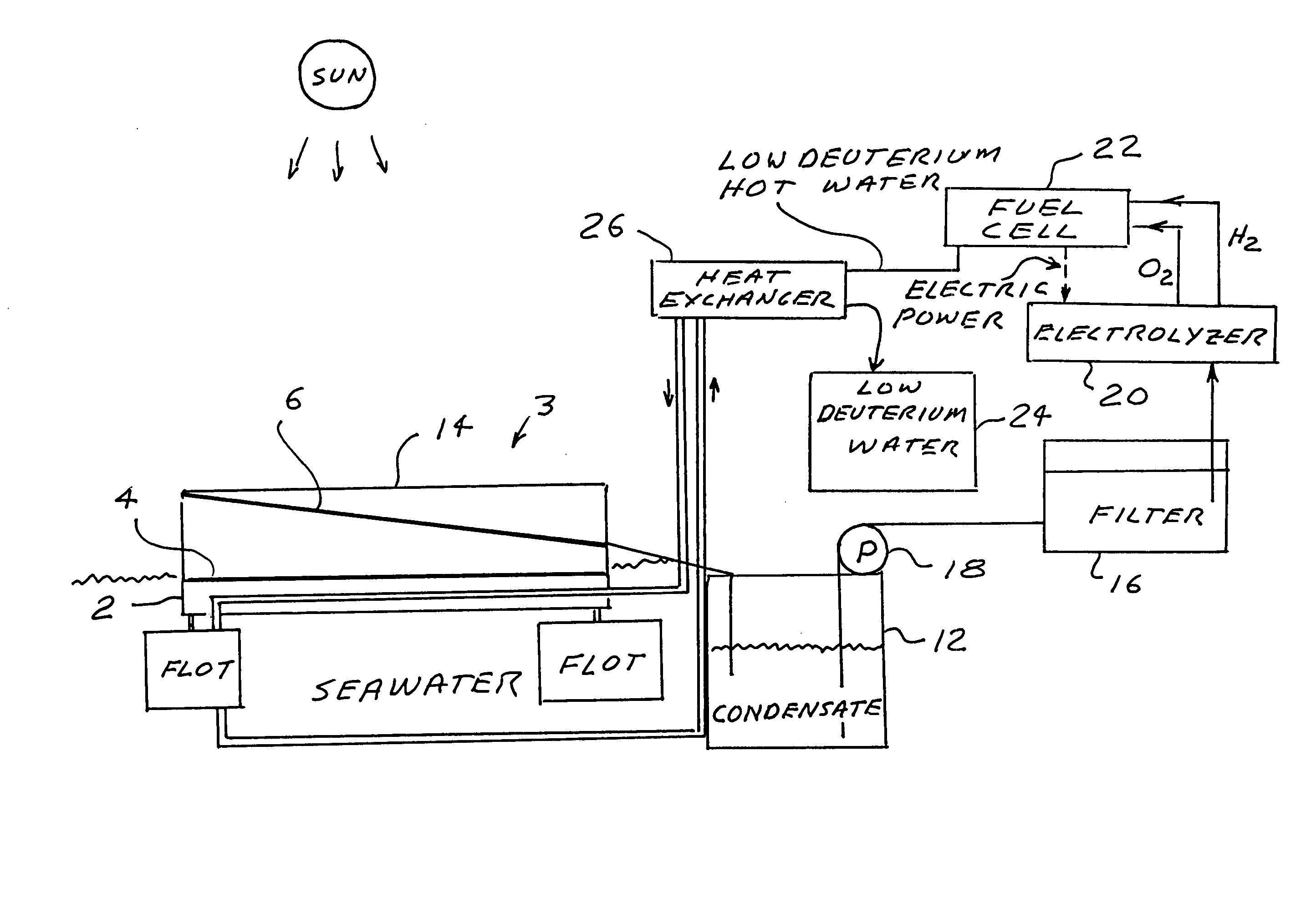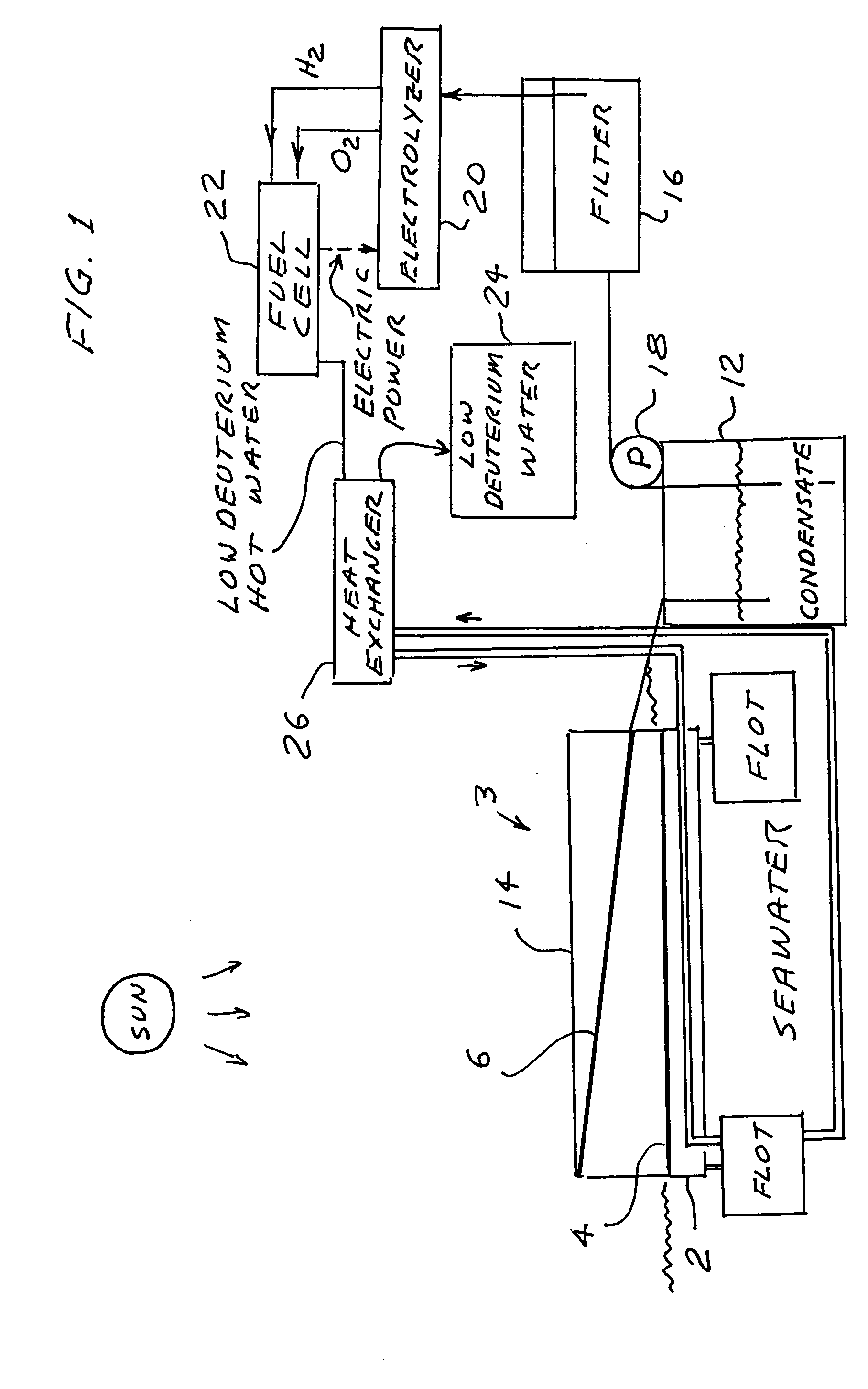Plant for producing low deuterium water from sea water
a technology for water plants and sea water, which is applied in waterborne vessels, refrigeration machines, refrigeration components, etc., can solve the problems of high energy consumption, high cost of methods, and high deuterium in drinking water, so as to improve the efficiency of still water production, low deuterium, and low cost
- Summary
- Abstract
- Description
- Claims
- Application Information
AI Technical Summary
Benefits of technology
Problems solved by technology
Method used
Image
Examples
first preferred embodiment
[0015] A first preferred embodiment of the invention can be used for production of low deuterium water from seawater can be described by reference to FIGS. 1-4. A large flat black porous pan 2 made from polymer microporous hydrophilic material and floting on the sea permits seawater to diffuse through porous pan 2. Water collects as shown at 4 on the top surface of pan 2 and is heated by radiation from the sun passing through membranes 14 and 6. Water is evaporated from surface of the water and the resulting vapor condenses on membrane 6 which is made from microporous light-penetrable hydrophilic material and is reinforced with polymer beams. Membrane 6 is several degrees colder than the water vapor. The condensate once collected diffuses through the member from its bottom surface to its top surface. This membrane is made with saw shaped surface as shown at 8 in FIG. 2B. The lower angle part of the membrane is needed for collection of the condensate. Membrane 6 is placed at an angle...
second preferred embodiment
[0021] A second preferred embodiment of the present invention is a ground based plant as shown in FIG. 5. Ground placement of the plant includes the flat black pan 40 which can be made from any sloped plastic or metallic material with metallic tubes 42 inside the pan. Arrow 44 shows the direction of the heat carrier. Sea water is added on the black sloped surface by pump 18A and water is circulated in a loop consisting of tank 12A black pan 40 and pump 18A. The roof 14A can be made from polymer material or glass and it has a slope. The condensate flows down into distillate trough 44. An insulation layer 46 is placed under tubes 42. The entire unit is placed on concrete pad 48. Other parts of the system are the same as it was described above.
examples
[0022] A preferred example is a system that produces 1 kg condensate / hr by evaporation. Percentage of the condensate volume used for electrolysis (PE) should be no more than 80%. Parameters of the system and operating parameters are outlined below: [0023] 1. If PE=75% than from 1 kg of a condensate we will use 0.75 kg and 0.25 kg will be in the brine. The splitting reaction is H2O=H2+½O2. From 0.75 kg of water is produced 1 m3H2 and 0.5 m3 O2. [0024] 2. Efficiency of electrolysis is 4.2 kWh for production of 1 m3H2. [0025] 3. Efficiency (Eff) of alkaline fuel cell is 60-70%. The efficiency for fuel cell is Eff=Vc / 1.48, where Vc is the voltage on the fuel cell. For Eff=67.5% the Vc is 1.0V. [0026] 4. Electrical energy can be calculated from the formula:
O2 usage=25.28×10−5×Pc / Vc(Pc-fuel cell energy), m3 / hr [0027] For 0.5 m3 O2 the Pc is 2 kWh. This is recovery energy which is used for electrolysis. So, the energy recovery is (2 / 4.2)×100%=47.6% [0028] Water production can be calculate...
PUM
| Property | Measurement | Unit |
|---|---|---|
| Fraction | aaaaa | aaaaa |
| Fraction | aaaaa | aaaaa |
| Length | aaaaa | aaaaa |
Abstract
Description
Claims
Application Information
 Login to View More
Login to View More - R&D
- Intellectual Property
- Life Sciences
- Materials
- Tech Scout
- Unparalleled Data Quality
- Higher Quality Content
- 60% Fewer Hallucinations
Browse by: Latest US Patents, China's latest patents, Technical Efficacy Thesaurus, Application Domain, Technology Topic, Popular Technical Reports.
© 2025 PatSnap. All rights reserved.Legal|Privacy policy|Modern Slavery Act Transparency Statement|Sitemap|About US| Contact US: help@patsnap.com



